SOCIOLINGUISTICS-INTRODUCTION
超全sociolinguistics
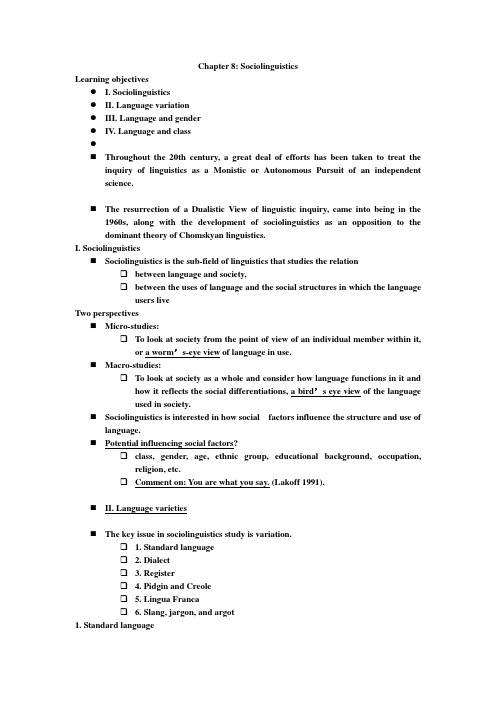
Chapter 8: SociolinguisticsLearning objectives●I. Sociolinguistics●II. Language variation●III. Language and gender●IV. Language and class●⏹Throughout the 20th century, a great deal of efforts has been taken to treat theinquiry of linguistics as a Monistic or Autonomous Pursuit of an independent science.⏹The resurrection of a Dualistic View of linguistic inquiry, came into being in the1960s, along with the development of sociolinguistics as an opposition to the dominant theory of Chomskyan linguistics.I. Sociolinguistics⏹Sociolinguistics is the sub-field of linguistics that studies the relation❑between language and society,❑between the uses of language and the social structures in which the language users liveTwo perspectives⏹Micro-studies:❑To look at society from the point of view of an individual member within it, or a worm’s-eye view of language in use.⏹Macro-studies:❑To look at society as a whole and consider how language functions in it and how it reflects the social differentiations, a bird’s eye view of the languageused in society.⏹Sociolinguistics is interested in how social factors influence the structure and use oflanguage.⏹Potential influencing social factors?❑class, gender, age, ethnic group, educational background, occupation, religion, etc.❑Comment on: You are what you say. (Lakoff 1991).⏹II. Language varieties⏹The key issue in sociolinguistics study is variation.❑ 1. Standard language❑ 2. Dialect❑ 3. Register❑ 4. Pidgin and Creole❑ 5. Lingua Franca❑ 6. Slang, jargon, and argot1. Standard language⏹George Bernard Shaw, Pygmalion⏹ A particular variety of a language is better than any other.⏹This dominant, or prestigious variety is often called standard variety orstandard language/dialect⏹Quote: A language is a dialect with an army and navy.⏹Question: what is the definition of the standard language in China?⏹普通话的定义:❑以北京语音为标准音, 以北方话为基础方言, 以典范的现代白话文著作为语法规范的现代汉民族共同语。
sociolinguistics
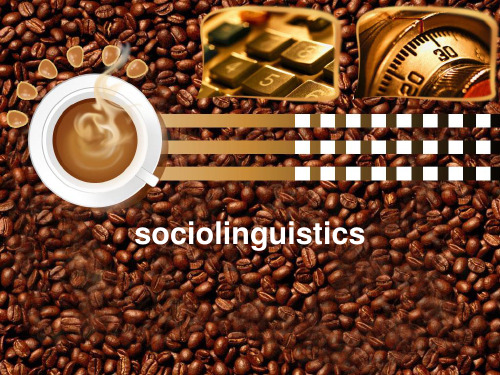
• One of the principal uses of language is to communicate meaning, but it is also used to establish and to maintain social relationships. • It is the second function of language use that sociolinguists study.
• Regional/geographical dialects: • Varieties of a language spoken in a geographical area, such as Cockney dialect, and Yorkshire dialect in Britain, or North Midland dialect and South Midland dialect in the United States, and Guangdong dialect in China.
• Sociolects and standard dialects are often confused because they are interpreted only in terms of prestige. • In due course the sociolect with the highest status in a country often acquires the status of the standard dialect.
• A regional dialect is a variation of language different enough to be classed as a separate entity, but not different enough to be classed as a separate language. • Sometimes a dialect rises in status and becomes the standard variety of a country, becoming standard dialect, e.g. standard English, standard Chinese.
英语语言学概论第八章笔记
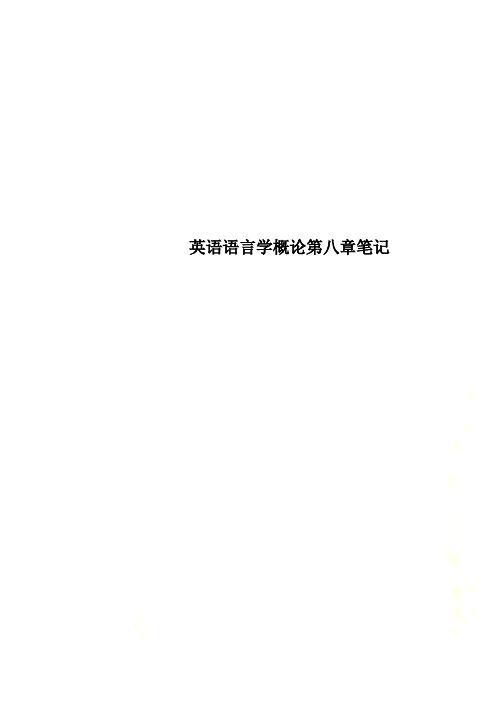
英语语言学概论第八章笔记Chapter 8 Socio-linguistics 社会语言学1.What is socio-linguistics? 什么是社会语言学?Sociolinguistics is the sub-discipline of linguistics that studies language in social contexts.社会语言学是语言学的一个分支,它研究社会环境中的语言。
nguage variation 语言变异a)S peech community 言语社区In sociolinguistic studies, speakers are treated as members of social groups. The social group isolated for any given study is called speech community. A speech community thus defined as a group of people who form a community (which may have as few members as a family or as many member as a country), and share the same language or a particular variety of language. The important characteristic of a speech community is that the members of the group must, in some reasonable way, interact linguistically with other members of the community. They may share closely related language varieties, as well as attitudes toward linguistic norms.社会语言学研究中,说话者被当作是社会群体的成员。
《简明英语语言学教程》导学手册
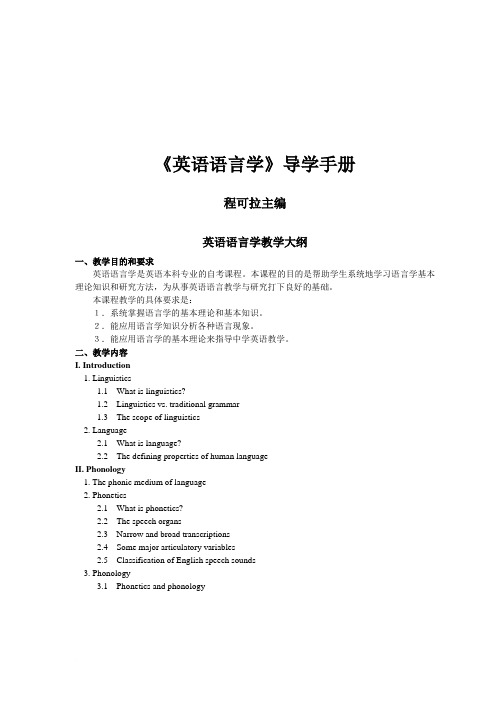
《英语语言学》导学手册程可拉主编英语语言学教学大纲一、教学目的和要求英语语言学是英语本科专业的自考课程。
本课程的目的是帮助学生系统地学习语言学基本理论知识和研究方法,为从事英语语言教学与研究打下良好的基础。
本课程教学的具体要求是:1.系统掌握语言学的基本理论和基本知识。
2.能应用语言学知识分析各种语言现象。
3.能应用语言学的基本理论来指导中学英语教学。
二、教学内容I. Introduction1. Linguistics1.1 What is linguistics?1.2 Linguistics vs. traditional grammar1.3 The scope of linguistics2. Language2.1 What is language?2.2 The defining properties of human languageII. Phonology1. The phonic medium of language2. Phonetics2.1 What is phonetics?2.2 The speech organs2.3 Narrow and broad transcriptions2.4 Some major articulatory variables2.5 Classification of English speech sounds3. Phonology3.1 Phonetics and phonology3.2 Phone, phoneme and allophone3.3 Phonemic contrast, complementary distribution, and minimal pair3.4 Some rules of phonology3.5 Suprasegmental features---Stress, tone, intonationIII. Morphology1. Morphology1.1 Open classes and closed classes1.2 Internal structure of words and rules for word formation2. Morphemes---the minimal units of meaning3. Derivational and inflectional morphemes4. Morphological rules of word formation5. CompoundsIV. Syntax1. Syntax1.1 What is syntax?1.2 Sentence2. Structuralist approach2.1 Form classes2.2 Constituent structure2.3 Immediate constituent analysis2.4 Endocentric and exocentric constructions2.5 Advantage of IC analysis2.6 Labelled tree diagram2.7 Discontinuous constituents3. Transformational-generative grammar3.1 Competence and performance3.2 Criteria for judging grammars3.3 Generative aspect3.4 Transformational aspect3.5 Deep and surface structures4. The Standard Theory4.1 Components of a TG4.2 The base4.3 Transformations4.4 The form of T-rules4.5 The phonological component4.6 The semantic componentV. Semantics1. Semantics1.1 What is semantics?2. Some views on semantics2.1 Naming things2.2 Concepts2.3 Context and behaviourism2.4 Mentalism3. Lexical meaning3.1 Sense and reference3.2 Synonymy3.3 Polysemy and homonymy3.4 Hyponymy3.5 Antonymy3.6 Relational opposites4. Componential analysis4.1 Componets of meaning4.2 Meaning relations in terms of componential analysis5. Sentence meaning5.1 How to define the meaning of a sentence?5.2 Selectional restrictions5.3 Basic statements about meaning6. The semantic structure of sentences6.1 Extended use of componential analysis6.2 Prediction analysis6.3 Subordinate and downgraded predictions6.4 Advantages of predication analysisVI. Pragmatics1. What does pragmatics study?2. Speech act theory3. Principles of conversation3.1 The co-operative principle3.2 The politeness principleVII. Language change1. Introduction2. Sound change3. Morphological and syntactic change3.1 Change in “agreement” rule3.2 Change in negation rule3.3 Process of simplification3.4 Loss of inflections4. V ocabulary change4.1 Addition of new words4.2 Loss of words4.3 Changes in the meaning of words5. Some recent trends5.1 Moving towards greater informality5.2 The influence of American English5.3 The influence of science and technology6. Causes of language changeVIII. Language and society1. The scope of sociolinguistics1.1 Indications of relatedness between language and society1.2 Sociolinguistics vs. traditional linguistic study1.3 Two approaches in sociolinguistics2. Varieties of language2.1 Varieties of language related to the user2.2 Standard dialect2.3 Varieties of language related to the use3. Communicative competence4. Pidgin and creole5. Bilingualism and diglossiaIX. Language and culture1. Introduction2. What is culture?3. Language and meaning4. Interdependence of language and culture5. The significance of cultural teaching and learning6. Linguistics evidence of cultural differences6.1 Greetings6.2 Thanks and compliments6.3 Terms of address6.4 Colour words6.5 Privacy and taboos6.6 Rounding off numbers7. Cultural overlap and diffusion8. ConclusionX. Language acquisition1. Introduction1.1 Language acquisition1.2 The beginning of language1.3 Stages in first language acquisition1.4 Age and native language acquisition1.5 Common order in the development of language1.6 Different rate of language development2. Phonological development2.1 Regular sound development2.2 Mother and father words2.3 Grammatical development2.4 Vocabulary development2.5 Sociolinguistic development3. Theories of child language acquisition3.1 A behaviorist view of language acquisition3.2 A nativist view of language acquisitionXI. Errors analysis and second language acquisition1. Differences and similarities between first and second language acquisition2. The inadequacy of imitation theory3. Interference3.1 Phonological evidence3.2 Lexical evidence3.3 Grammatical evidence4. Cross-association5. Overgeneralization6. Strategies of communication7. Performance errors三、教学原则和方法1.启发式教学原则:教师积极引导学生理解分析问题,发挥学生的主观能动性,培养他们综合分析问题解决问题的能力。
Sociolinguistics
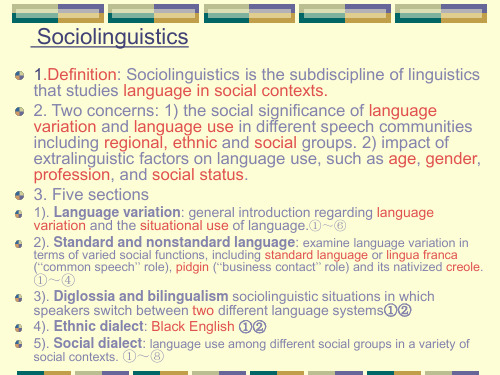
1.Definition: Sociolinguistics is the subdiscipline oguage in social contexts. 2. Two concerns: 1) the social significance of language variation and language use in different speech communities including regional, ethnic and social groups. 2) impact of extralinguistic factors on language use, such as age, gender, profession, and social status. 3. Five sections
1. Two definitions: 1) A speech community: a group of people who form a community and share the same language or a particular variety of language. 2) A social group: besides regionally, a social group may distinguish
Contents: 1. Speech community 2. Speech variety 3. Regional variation 4. Social variation 5. Stylistic variation 6. Idiolectal variation
Speech community
3. Language variation → → → → 1. Education varieties 4. Social dialect → →Age varieties 2. 3. Gender varieties 5. Ethnic dialect 4. Register varieties
chapter 8 Sociolinguistics
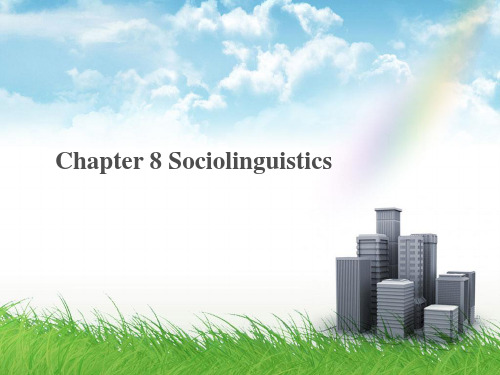
2.3 Registers 语域 Registers are also marked by syntactic variables:
I should be grateful to you if you would make less noise. Please be quiet.
Shut up.
The use of an inappropriate register is one
Chapter 8 Sociolinguistics
Contents
1. Introduction 2. Language Varieties
3. Choosing a Code }4. Linguistic Taboos and Euphemisms 5. Language and Gender
2.3 Registers 语域 We speak in different ways on different occasions. These varieties classified according to use are called registers. Registers can differ in vocabulary, phonology, grammar and semantics. (Classroom register --- dorm register)
classed as a separate entity, but not different
enough to be classed as a separate language. (Tianjing dialect --- Wuhan dialect)
When a dialect is standardized and given the status by the authority, it has become the standard variety of a country.
Chapter 8 Sociolinguistics
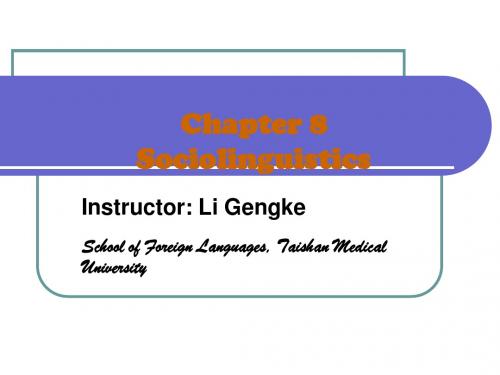
Temporal dialects varieties of a language used at particular stages in its historical development. There are two major temporal dialects in Chinese — classical Chinese and modern Chinese. In English, there are marked differences between Old English and Middle English, and between Middle English and Modern English.
Many linguists have tried to work out theories to describe the relationship between social variables and linguistic features. A well-known version of these theories is M. A. K. Halliday’s register theory.
When we study language in relation to society, it is called sociolinguistics. In sociolinguistics we are interested in how social factors influence the structure and use of language. It is the field that studies the relations between language and society, between the uses of language and the social structures in which the users of language live. It is also a field of study that assumes that human society is made up of many related patterns and behaviors, some of which are linguistic.
Sociolinguistics (1)1

3) In 1949, an American linguist Mario Pei published a book “The Story of Language”, in which he mainly discussed about the social factors that might influence language.
• The students, therefore, should first of all get to know the development in sociolinguistic study and renowned sociolinguists and their specific areas of the study in the recent decades.
but linguists started to notice that language was a social phenomenon or a social behavior long before this sub-discipline was established. The interaction between language and society has existed ever since people began using language, hence there has been the variation of the language.
英语语言学概论第八章笔记

Chapter 8 Socio-linguistics 社会语言学1.What is socio-linguistics? 什么是社会语言学?Sociolinguistics is the sub-discipline of linguistics that studies language in social contexts.社会语言学是语言学的一个分支,它研究社会环境中的语言。
nguage variation 语言变异a)Speech community 言语社区In sociolinguistic studies, speakers are treated as members of social groups. The social group isolated for any given study is called speech community. A speech community thus defined as a group of people who form a community (which may have as few members as a family or as many member as a country), and share the same language or a particular variety of language. The important characteristic of a speech community is that the members of the group must, in some reasonable way, interact linguistically with other members of the community. They may share closely related language varieties, as well as attitudes toward linguistic norms.社会语言学研究中,说话者被当作是社会群体的成员。
An introduction to sociolinguistics

My Review of The Sociolinguistics of LanguageThe term sociolinguistics is a compound word composed of socio and linguistics, in which socio stands for “sociology”. Broadly speaking, sociolinguistics is a science that studies the social functions and meaning of language and its relation to society by using theories from linguistics and other social sciences such as sociology, anthropology, ethnography, psychology geography, philosophy and history. As a matter of fact, there have existed different terms referring to this newborn subject at the beginning. As a new subject, sociolinguistics appeared in the 1960s under certain conditions.Firstly, specific social conditions are closely related to its appearance. Ever since the 1930s, dramatic social, political and economic changes have taken place in the world and they greatly influence people’s perceptions to the world, including language which becomes an important part in the formation of a nation. Therefore, it is a great issue for linguists to do researches upon the sociolinguistics of language.This book is the companion volume to Ralph Fasold’s The Sociolinguistics of Society, pressed by Basil Blackwell in Great Britain in 1990. Ralph Fasold is a Professor Emeritus of Linguistics at Georgetown University. He is an expert in Formal and Functional Explanation in Syntax, Language Policy, Language Maintenance and Shift, Syntax and Sociolinguistics of Ebonics.This textbook, examines the influence of social interaction in language use and discusses a variety of facts about language from the commonplace to the exotic. Questions not normally asked about everyday phenomena are raised and little known facts about language use in social contexts are explored. For example, how does one decide when it is appropriate to address someone by their first name? Why do West Indians in service occupations sometimes seem rude to their customers? Why do men in Western Societies use more local dialect forms and lower status speech forms than do women? Can it be that the often despised languages called pidgin offer important clues to the inborn human capacity for language? There are just a few of the fascinating questions explored in this lively and informative textbook.The author has tried to draw attention to the issues that arise in dealing with these topics and have deliberately avoided giving a “simplistic” account of any one of them. To let students best exposed to a new area of interest, the author has tried to show why certain findings and issues are important, other controversial, and still others worthy of more attention than they sometimes get. He has also provided a wealth of references since it is important to encourage beginners to look at the literature and not just take for each chapter to encourage the early development of a “hands on”approach and the idea that all claims require empirical support. This book belongs to the area of non-fiction and academic. It is obvious that a book of this kind draws on a variety of sources.As is known, before the 1930s, linguistics mainly focused on analysis and explanation of classical documents and made great achievements. However, the research data were not reliable and representative enough. By the 1930s, great progress had been made in research method, including random sampling and statistics. Meanwhile, dramatic development in science and technology has also created indispensable conditions for the birth of sociolinguistics. Finally, the birth of sociolinguistics is an evitable consequence of academic development itself. At the beginning of the 20th century, Saussure began to criticize historical comparative linguistics and established structural linguistics, thus the sociolinguistics became to spring up.There are some reasons why sociolinguistics became flourishing in the 1960s. Firstly, Linguistics had a strong desire to find more solid empirical basis for the theory of Linguistics in the 1960s. Secondly, the development of sociolinguistics is as an opposition to the dominant theory of Chomsky. The relationship between language and society has long been recognized and ermined. During the whole 20th century, a great deal of efforts has been made to treat the enquiry of Linguistics as monistic or autonomous pursuit of an independent science. Strongly influenced by the dominant view of Linguistic science, a separation of the structural study of language from its social context of usage was claimed, justified and reinforced. The resurrection of a dualistic view of linguistic inquiry came into being in the 1960s, along with the development of sociolinguistics as an opposition to the structuralism, which is stood for by Chomsky.In the beginning, sociolinguistics used to refer to all study of the social significance of language.The book is divided into nine chapters. Each chapter in the book puts emphasis on a topic about the effect of relatively small-scale social influences on language. The subject of the first chapter points up the impact of address forms on social language, which is a good way to begin because the linguistic forms involved are simple, limited in number. Address forms make the fundamental point in sociolinguistics clearly. Considerably, the phenomena differ from one cultural setting to another so this topic leads naturally to the ethnography of communication, which is the subject of chapter two. On the border between sociolinguistics and anthropology, the ethnography of communication nicely illustrates anthropological methods and approaches to sociolinguistic themes. The third chapter, discourse analysis, contains a wide scope and a large and growing scholarly literature. It is so much that the author just tried to give the flavor of what is done in two subdivisions, conversation and the structure of texts, by discussing an important topic in each. For conversation, research on turn-talking provides the theme. For the text analysis, it was the relationship between grammar and discourse. In the topic of chapter four, language and gender has been an important issue for quite some time. Very recent work has indicated that it may soon be considered a central factor in sociolinguistic variation and the interaction between language and gender is definitely seen in daily life. The fifth and sixth chapter is on the linguistic pragmatics, referring to conversational implicature, speech acts, presupposition, indexical and politeness. The main ideas have shed considerable light on just aspect of sociolinguistics. Pidgins and creoles are the subject of the seventh chapter. Research of pidgins and creoles has inspired many of the insights in sociolinguistic variation studies. The chapter includes a rather long section on US Vernacular Black English (VBE), since it has been widely assumed that it has creole origins. The creole origin hypothesis has been called into some question with the development of the “divergence” controversy, involving evidence that the vernacular variety of US Black English is becoming progressively less like other varieties of American English. Chapter 8 is an overview of what has been the centerpiece of thesociolinguistics of language over the past thirty years or so, variation analysis. The final chapter is about the applications of the research discussed in the earlier chapters to social problems and issues. In this chapter, the author discovered a lot of applied research there has been since the 1960s, when the application of variation research to language arts education made up the great bulk of what existed. Since then there has been more work on first language teaching, but a lot has been done in areas like machine, law, bilingual education, advertising, and second language teaching.This book provides an excellent introduction to the subject in a concise and lucid way; therefore it is very ideal and suitable for the beginning students in the area. As it is an elementary book, it is definitely abroad in the discipline of sociolinguistics. Especially the exclamation from Piaget to the linguistic theory of Chomsky, it applies a lot of chats and examples to instructing certain theoretical issues in an iconic and scientific way.I am most interested in the chapter, Language and Sex, which drives me into deep thought. Sex differences are a fundamental fact of human life and it is not surprising to find them reflected in language. There are a few languages with certain phonological and morphological forms that are only appropriate for use by women and others that only men can use. Sociolinguistic survey research has turned up a phenomenon, the gender pattern, which involves the different usage of certain status-marking linguistic forms by sex. In particular, those forms revealed as disfavored by overall patterns of class and style stratification are used more frequently by men than by women, especially in the more formal speech styles. The author regards this phenomenon as a particular feature of Western societies. In fact, such rules and styles also appear in our Chinese societies. With the long history, China keeps a manner of tradition in society, culture and science. The traditional gender issues may be more fundamental as an impact on sociolinguistic variation than we recognized before. This may cause substantial rethinking about the significance of the sociolinguistic gender pattern. A case can be made that the prescriptive use of the generic masculine runs counter to sex in nature. I can’t agree with it any more, because in nature, female is the basic and unmarked sex. There are a number ofexamples where the males exist to extent that they are required for reproduction and in some species they are disposed of as soon as they fulfill that role. In language, the explicit reference to female sex tends strongly to have connotations of biological reproduction. This show up in the dictum that male are used unless explicit reference to femaleness is required, and in the frequent sexual connotations that are associated with the female-referring members of pairs.This book raises the following issues: Address Forms; the Ethnography of Communication; Discourse; Language and Sex; Linguistic Pragmatics; Pidgin and Creole Languages; Linguistic Variation and Some application. Especially, the author leaves out the applications to English language learning. Research in the sociolinguistics of language has always been accompanied by a strong emphasis on applications of the results to social problems. The first set of problems sociolinguistics tried to help solve was in education. Since then, sociolinguistic research has been applied to other professions, including the law, medicine, advertising and even interpersonal interaction. The author put more focus on the public education, so considerable effort and some bright success can be found in the interaction of sociolinguistics and legal issues. There are many specific applications of discourse analysis, pragmatics, and the ethnography of communication and variation analysis in language and law contexts. It is also clear that sociolinguistics knowledge can make a substantial contribution to efforts to interpret clearly what laws say for ordinary citizens.In conclusion, the Sociolinguistics of Language provides us with a perspective of language science and research. I benefit a lot from the broad field of research and the strong academic theory. The author makes me understand the wide range of sociolinguistic language, which not only be used in people’s communication but also be applied in the laws and medical profession. This sort of nature problems tends to be a new area that seems to have more promise than accomplishment.。
自考 chapter 8 Sociolinguistics
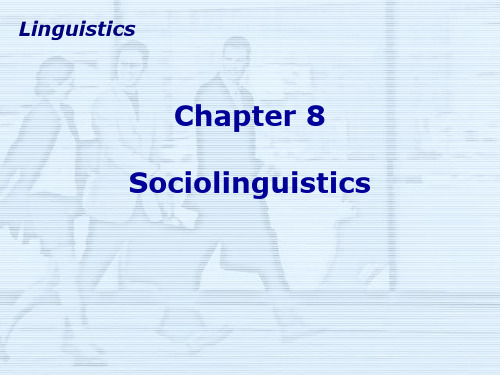
• • • • •
Example 1 (Ray, a student, comes home after school.) Ray: Hi, mum. Mum: Hi. You‟re late. Ray: Yeah, that bastard Sootbucker Kept us in again. • Mum: Nana‟s here. • Ray: Oh sorry. Where is she? • • • • • Example 2 (Leaving school, Ray runs into the school principal.) Ray: Good afternoon, sir. Principal: What are you doing here at this time? Ray: Mr. Sutton kept us in, sir.
• Linguistic phenomena are placed in the general context of society. • People‟s use of language is in part determined by his social background.
8.1.1 Speech community (言语社团)
8.1.3.1 Geographical variation
Geographical variation, which refers to the variation of languБайду номын сангаасge across geographical regions, can be generally divided into international variation and regional dialects. International variation refers to the variation of a language among different nations and is best exemplified by the American English and British English. Regional dialect denotes the variations within one country.
社会语言学家简介

社会语言学家简介费什曼:费什曼,美国语言学家,是社会语言学的奠基者和语言社会学的创始人,是双语教育和少数族裔语言保护的强有力支持者。
他的许多研究,如依地语、双语制和多语制、语言规划、语言复兴和保存、语言转用、小族语和全球化等,在社会语言学界产生了重要影响。
由他创办和主编的《国际语言社会学期刊》为研究者提供了学术促进了社会语言学的国际传播。
费什曼的学术贡献主要表现在语言保存理论、语言规划理论的建设和实践,及学术传承等多个方面。
费什曼在其漫长的学术生涯中出版了近100部著作,发表了1000余篇论文。
研究内容涵盖依地语、双语和多语制、语言规划、语言转用、语言复兴、语言和民族主义、语言和宗教、语言和思维、语言和种族等,而小族语言和濒危语言的保护一直是他研究的重心。
费什曼以依地语研究为起点,逐渐走向社会语言学研究之路,多视角探索语言和社会的问题。
如果说威廉·拉波夫是微观社会语言学(变异社会语言学)的创始人,费什曼则是宏观社会语言学(语言社会学)的奠基者。
他在宏观上关注语言教育、语言规划、双语制和多语制、小族语言及语言复兴,从社会视角探讨语言和民族主义、语言和认同、语言和种族的关系,他的思想观点和研究范式被加西亚等学者称为费什曼社会语言学,被以色列语言学家佐克曼称为“复兴语言学”。
布莱特:布莱特(W. Bright, 1966),他认为社会语言学是研究语言变异。
研究内容涉及七个方面:1. 说话者的社会身份;2. 听话者的身份;3. 会话场景;4.社会方言的历时与共时研究;5. 平民语言学;6. 语言变异程度;7. 社会语言学的应用。
他的视角涉及语境、语言的历时与共时。
他的重点放在“语言变异”上,社会语言学本身也是以变异为立足点。
祝畹瑾:女,1933年生,上海市人。
1954年北京大学西方语言文学系毕业。
1980—1981年美国州立密执安大学语言学系进修。
现任北京大学英语系教授。
主要研究社会语言学。
主要论著有:社会语言学概论/社会语言学译文集/社会语言学述译/南斯拉夫的社会语言学/语码转换与标记模 /Tongzhi in China: Language Changeand Its Conversational Consequences (Language inSociety Vol. 12,1983; 中文稿《“同志”在中国——语言变化对日常会话的影响》载胡文仲主编《文化与交际》,外语教学与研究出版社1994 ) /The MultipleMeaning of shifu: A Language in Progress(Anthropological Linguistics Fall,1984,以上两篇英文稿均与Carol Myers Scotton合署)/“师傅”用法调查 (语文研究1984. 1) /汉语称呼研究——一张社会语言学称呼系统图 (北京大学学报·英语语言文学专刊 1990) /Some Economic Aspects of the LanguageSituation in China (Journal of Asian PacificCommunication Vo. 2,No. 1,1991; 中文稿《语言的市场价值》语言文字应用1992. 2,以上英、中文稿均与陈建民合署)等。
introduction to sociolinguistics社会语言学
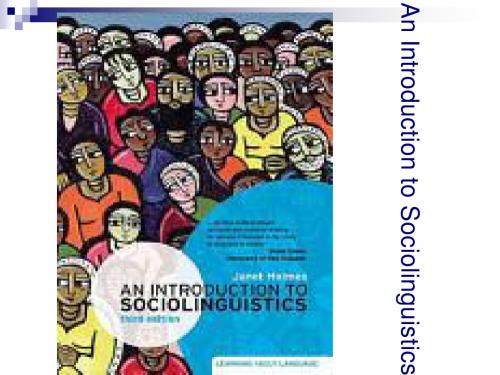
Content
Diglossia
Code-switching
双语体
语码转换 语言更换 语言维持 皮钦语和克里奥耳语 方言
Language shift
Language maintenance Pidgins and Creoles Dialects …
Teaching Material
Janet Holmes (Professor of
Linguistics at Victoria University of Wellington who specializes in sociolinguistics, language and gender issues)
An Introduction to Sociolinguistics
First published in 1992 A classic introductory book Characterized by concise and intelligible language
?
2. Sarah: I think everyone’s here except Mere.
John: She said she might be a bit late but actually I think that’s her arriving now.
Sarah: You’re right. Kia ora Mere. Haere mai. Kei te pehea koe?
An Introduction to Sociolinguistics
Questions
1. H.L.Menken wrote a series of books under the general title The American Language. Why did he choose this particular title? Why not The English Language in America?
An introduction to sociolinguistics 笔记

《社会语言学引论》Wardhaugh, R. (沃德霍),北京:外语教学与研究出版社,2000.81. the scientific investigation of language(p.5)1.1 Bloomfield(1933): contrastive distribution (/p/ and /b/)1.2 Saussure(1959): Langue(group knowledge of language)Parole(individual use of language)1.3 Sapir(1921) &Chomsky(1965): “surface”characteristics ofutterances vs. “deep”realities oflinguistic form1.4 Pike(1967): emic(phonemic) 音位 VS. etic(phonetic)语音1.5 Comrie(1989): language universalLabov(1994): linguistic change2. Relationships between language and society (p. 10-11)2.1 social structure may either influence or determine linguistic structure and/or behavior2.2 linguistic structure may either influence or determine social structure and/or behavior: sexist2.3 bi-directional: language and society may influence each other 2.4 there is no relationship3. Scholars’ views on sociolinguistics vs. the sociology of language (p.12-13)4. basic methodological concerns (p.16)4.1 be oriented toward: Data +theory---we must collect data for a purpose instead of ‘butterfly collecting’, and that the purpose should be to find an answer, or answers, to an interesting question. Questions phrased in ways that do not allow for some kind of empirical testing have no more than a speculative interest.4.2 good question + the right kinds of dataStudies of the possible relationships between language and society: Correlational ; implicational; microlinguistic(specific items); macrolinguistic(group relationship)4.3 ①the sources of data base: censuses, documents, survey, interviews, obvervation,②Devices: graphing, scaling, categorizing③Data collecting and analysis: sampling techniques, error estimation, confidential level④principles(Bell,1976, pp.187-91): cumulative, uniformation, convergence融合, subordinate shift, style-shifting, attention,vernacular(本国语),formality(形式性)。
Sociolinguistics_1_Introduction
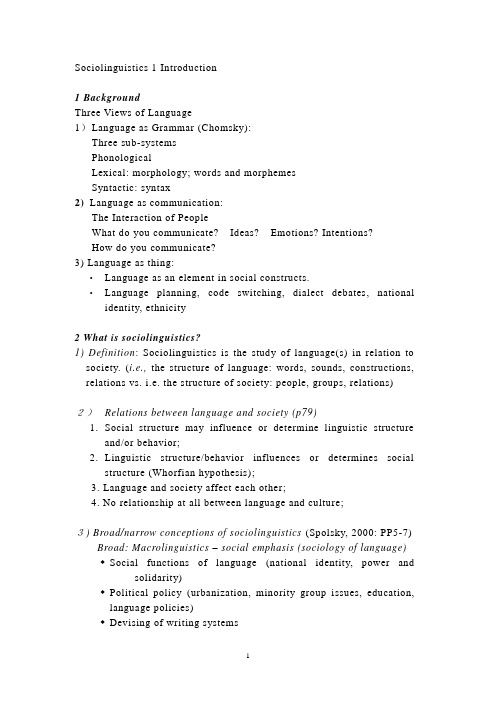
Sociolinguistics 1 Introduction1 BackgroundThree Views of Language1)Language as Grammar (Chomsky):Three sub-systemsPhonologicalLexical: morphology; words and morphemesSyntactic: syntax2)Language as communication:The Interaction of PeopleWhat do you communicate? Ideas? Emotions? Intentions?How do you communicate?3) Language as thing:•Language as an element in social constructs.•Language planning, code switching, dialect debates, national identity, ethnicity2 What is sociolinguistics?1) Definition: Sociolinguistics is the study of language(s) in relation tosociety. (i.e.,the structure of language: words, sounds, constructions, relations vs. i.e. the structure of society: people, groups, relations)2)Relations between language and society (p79)1.Social structure may influence or determine linguistic structureand/or behavior;2.Linguistic structure/behavior influences or determines socialstructure (Whorfian hypothesis);3. Language and society affect each other;4. No relationship at all between language and culture;3) Broad/narrow conceptions of sociolinguistics (Spolsky, 2000: PP5-7) Broad: Macrolinguistics – social emphasis (sociology of language) ♦Social functions of language (national identity, power and solidarity)♦Political policy (urbanization, minority group issues, education,language policies)♦Devising of writing systems♦Language use in the constitution of individual identity (dialect show where a person comes and register reveals what hedoes)♦How conversational patterns signify community membership (e.g., black English, deletion of BE)Narrow: microlinguistics –language emphasis:variation at some level of the grammar (sociolinguistics): e.g.,1) Regional difference:行动电话(台湾)--移动电话(大陆说法)便当(台湾)--盒饭(大陆用语)公德心(台湾)--精神文明(大陆用语)超音波(台湾)--超声波(大陆用语)撞球(台湾)--台球(大陆用语)2)GreetingEnglish: Hi, how are you? How do you do? Morning? Good Morning?Chinese: 你好?吃饭了吗?最近好吗?你死哪去呢?3) Naming in English(Title + Given name + Family name)Who am I? (Richard Hudson)Professor HudsonDr R A HudsonRichard HudsonHudsonHudson, RichardDickDadPossible combinations:T G F Professor Richard HudsonT F Professor HudsonG F Richard/Dick HudsonG Richard/DickT Doctor ok for some titlesF Hudson NB: old-fashioned!Not: T F Professor Dick ungrammatical!!Consider the Solidarity and PowerTo superior stranger: TF (Mr Smith)To subordinate relative: G (John) Father to sonTo superior relative: T (Dad) son to fatherTo equal acquaintance: G (colleagues)To superior acquaintance: ? (clerk vs. boss)(Question: Any difficulty in addressing a person?)Addressing term of the first pronoun in Chinese “我”西周汉语的语料中,有"我、余(予)、朕、印、吾",我,咱、俺(在先秦时代,“朕”是第一人称代词。
SOCIOLINGUISTICS(1)

Chapter One: Introduction
1.1 What is sociolinguistics? Sociolinguistics is a branch of linguistics which studies all aspects of the relationship between language and society. Sociolinguistics is a relatively new subdiscipline within linguistics which has grown in the past twenty or thirty years. It has been developed on the basis of linguistics, sociology, social psychology, social anthropology and other disciplines. Sociolinguistics is not a mechanical amalgamation of the above disciplines, but a scientific and organic integration of them. It is a marginal discipline as well as an independent one.
Peter Trudgill:
a. the structure of discourse and conversation b. speech acts c. studies in the ethnography of speakers d. investigations of such matters as kinship systems e. studies in the sociology of language, e.g. bilingualism, code-switching, and diglossia f. certain practical concerns such as various aspects of teaching and language behavior in classrooms g. variation theory and linguistic change
社会语言学导论(AnIntroductiontoSociolinguistics)

社会语言学导论(An Introduction to Sociolinguistics)The first chapter of theoryThe rise of social linguisticsAs of 1952 the birth time of American Society of linguistics; the Midwest sociological society that year, hutzler (He; txlef) first explicitly mentionTo stand out; influence of language and social structure; the relationship between language and social behavior. In 1964, American sociologists and linguists held a joint discussion of ammonia - "formally proposed and" social linguistics "recognized the name.From the historical development of linguistics itself, since Saussure (F.de.SaMssure) the strict distinction between language and speech, stressed that the synchronic rumor t internal languageThe importance of study since linguistics generally accepted his views. Many linguists study only focus on the internal structure of language and ignore the study of social function and variation of language. This trend is more prominent in the form of the language school. Although the development of linguistics since twentieth Century so we have a more comprehensive and more profound understanding of the internal structure of language, but the ideal is so complex of human language phenomenon has a comprehensive understanding is not only to stay on the internal structure of language description. Especially when this kind of research can not solve practicalproblems related to language use in current social life give us out of. Therefore, linguists can not distinguish a review of language and speech, internal linguistics and external linguistics, hoping to find a new way to combine them together, as is the combination of system and a variation of social linguistics theory.On the other hand, the development of other social sciences and humanities such as sociology, anthropology, psychology and so on also can provide a lot of transplantation or reference the concepts and methods of social linguistics. Then, with the nature of social linguistics across disciplines or interdisciplinary developed rapidly.The object of social linguistics and task two1, American Society of language educators Fishman (J.A.Fishman) think; function characteristics of sociolinguistic study of language blind varieties of these variants and use these variants into the characteristics of attention to these three factors in the continuous education group interaction and the changes in a language.2, the "Soviet encyclopedia third edition in" social linguistics "entry explanation is:" social linguistics research the following questions: language and nationality; historical category linked as formation and of ethnic minority languages in language social classification group structure level; be restricted by various types of language or dialect the social function of language in language in various social conditions; interaction rules; bilingualism, multilingualismand dialect phenomenon; especially research in the social environment of language as well as the social consciousness of language development and language policy."3, the British linguist Halidi (M.A.K.Halliday) believes that social linguistics at least the following fifteen fields:(1) the social and linguistic study, linguistic demography,(2) group (diaglossia), bilingualism multilingualism, multi dialect phenomenon(3) the rules of language, language development and specification(4) the language of the Kremlin and pidgin Hong Austria ear phenomenon;(6) social dialect, the non standard variant description,(6) social linguistics and teaching(7) the history of ethnic language, language education environment;(8) register, verbal ability, a language transition to another language.(9) the social factors of phonetic and grammatical changes,(10) language and society; language and culture;(11) the development of methods of social linguistics and child language,(12) the function theory of language system,(13) linguistic relativity(14) ethnic linguistics methodology(15) the theory of discourse.In short: the first is the study of the research object of macro sociolinguistics or social language. They are mainly about language and nationality, language policy, language planning, language standardization and other aspects of the subject.The second class is the research object of micro social linguistics or social linguistics. They mainly reflect the social phenomenon and process in the language, but also can be said to be all kinds of social varieties of language.The famous social linguist Labov (bov) is mainly to the so-called city dialect field in detail, the relationship to analysis of the results of the survey to reveal the race, class, education level, occupation, gender, age, social situations between various social factors and language variation. So some people have represented by Labov is engaged in this kind of social linguistics called City dialect group. While some American linguists to anthropologists, linguists as the representative Fishman focus on the study of bilingualcommunication, bilingual education, language policy, language planning and other issues on. The Soviet social linguists pay more attention to some issues on the research of macro sociolinguistics. Don't Dannuo husbandThe second chapter studies the social language view of languageA social psychological view of languageThe end of the last century, the beginning of this century, the social psychology of language school believes that language is a social phenomenon. This theory had been the French sociologist Toure J M (E.Durkheim) of view. Toure J M believes that the object of sociology is the collective social psychological system. The collective social psychological system is personal and external imposition. Saussure, founder of social psychology of the language school of this idea is applied to linguistics, speech that human activities include two aspects of language and speech; speech is talking in the physical and mental activity, and language is the social group to make the individual essential a set of possible to achieve this function to the social conventions. The language to be stored in theMany imprinted in everybody's mind in the form of exist in the collective. Saussure acknowledged that language and speech are interdependent, words to understand and produce all of it, there must be a language; and the language has been able to establish must also have a speech. But he also insisted that separate language and speech. What is the division because of this society, what is personal; what is important, what issubordinate and how much is accidental distinguish clearly. In other words, he believed that only language is systematic social, homogeneous, and the word is how much personal, heterogeneous, is an accidental phenomenon.Cable Xuer the most famous view is that language is not real form. In other words, it is a value system, sound or sound wave action is neither to analyze from physiological, physical, or specific meaning of words is not referring to things. As for the social factors and language are closely related, such as culture, ideology, national history, and so on, are listed in "external linguistics research, Never mind with the study of language. He advocated "the language and language and language". This language has become detached from the specific social environment, independent of the specific time and space pattern. Structural linguistics inherited Saussure's view. The generative linguistics is also moving in the same direction of view of language, they can be referred to as formal linguistics, the language from the social life and material abstracted, as all the members of the society in that basement system in a uniform. In such a system, if you want to talk about what the society, only the abstract "crowd". As for the social characteristics and differences of this group of people, and they are reflected in the language were not taken into account. To understand this language is a "social phenomenon" of course is different and the social linguistics.Two, how to treat the Stalin language and society"The Marx doctrine and the problems of linguistics"From the origin of language, there is no social no language.From the development of language, language development is with the development of society, in order to understand a language and its development rule, only closely related to the history of social development closely linked to create this language, a language used by people to study history.From the basic functions of language, not the whole society to the suburbs of adult language, society will stop production, will collapse, will continue to exist; that language is a tool of communication. In this sense, but also the social struggle and development tools.Three, how to treat the social linguistics, language is a social phenomenonFour, language variant (language variety)Five, language variant and prototype (prototype)Six, language varietyThe third chapter of language and culture, language variation and Society (a)。
语言学讲义 考研 7 Sociolinguistics
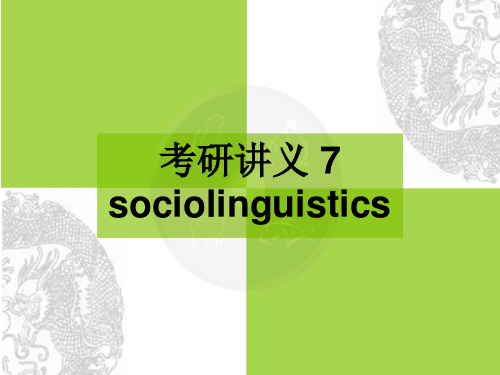
• Users of the same language in a sense all speak differently. What each of them chooses to use is in part determined by one’s social background.
– When we speak we cannot avoid giving our listeners clues about our origin and our background.
– 肥皂剧、卡通、布丁、苹果派、雀巢、巴士、 排挡、耐克、因特网、KTV、EMAIL – Typhoon, gongfu, etc.
15
Netspeak 网络语言
• • • • • • • • • • 顶(支持) 555(呜呜呜) ding(顶) mm/MM(妹妹) LZ(楼主) DD/dd(弟弟) 88(拜拜) 偶(我) 马甲(ID) ID • • • • • • • • • • 斑竹(版主) 恩(嗯) 汗或寒(敬畏) 晕(非常惊异) ps/PS(photoshop的简称) 灌水(发帖子) ddd(顶顶顶) bs/BS(鄙视) 楼猪(楼主) 滴(的、地) 16
9
• Sapir-Whorf Hypothesis
– Edward Sapir (1884 - 1939) and Benjamin Lee Whorf (1897-1941)
• Our language helps mould our way of thinking and, consequently, different languages may probably express speakers’ unique ways of understanding the world.
- 1、下载文档前请自行甄别文档内容的完整性,平台不提供额外的编辑、内容补充、找答案等附加服务。
- 2、"仅部分预览"的文档,不可在线预览部分如存在完整性等问题,可反馈申请退款(可完整预览的文档不适用该条件!)。
- 3、如文档侵犯您的权益,请联系客服反馈,我们会尽快为您处理(人工客服工作时间:9:00-18:30)。
• Society is any group of people who are drawn together for a certain purpose or purposes. • Language is what the members of a particular society speak.
2.4 Course Credit
• Final Assessment: • Part I: Daily Performance (40% ) Attendance Oral Presentation Essay Writing • Part II: Final Exam (60%)
2.5 Course Readings
3.2.Historical context
• • • • Langue and parole Structuralism Tranformational generative grammar Sociolinguistics
Saussure’s langue and parole
• Saussure is the father of modern lingusitcs and his distinction between langue and parole is a marvelous beginning of language study. • Langue(语言)--the abstract linguistic system shared by all members of a speech community. • Parole(言语)—the realization of langue in actual use. • Saussure takes a sociological view of language and his notion of langue is a set of conventions and rules users all have to abide by.
2.2 Teaching Objectives
During the study of the course, students are expected: • To learn the basic concepts and fundamental theories of sociolinguistics. • To understand how those social factors affect the use of language and different study methods employed. • To foster your awereness and sensitivity to the language variations.
Sociolingusitics
• Socoilinguistics no longer focuses on language structure itself to study language, but begin to consider the functions of language and looking for evidences of socially accepeted rules accounting for variations in speech. So it is a complementary and modification to the traditional linguisitic study.
• The set books for the required reading are: (1) Holmes, J. (2008) An Introduction to Sociolinguistics. 3rd edition. Harlow: pearson. (2) Montgomery, M. (2008) An Introduction to Language and Society. 3rd edition. London: Routledge. (3) Wardhaugh, R. (2010) An Introduction to Sociolinguistics. 6th edition. Oxford: WileyBlackwell. (4) 祝畹瑾. (2013) 新编社会语言学概论. 第1版. 出版 社: 北京大学出版社.
age
education
Language is affected by social factors
occupation
2. Course Description
• • • • • Course description Course objectives Course plan Course Credit Course readings
Sociolinguistics
--An Introduction
Introduction of Sociolinguistics
Warming up activities Course description Introduction to sociolinguistics
1. Warming up activities
Transformational generative grammar
• Tranformational generative grammar is the linguisitic achivements of American linguist Noam Chomsky. Accoding to the theory, all the sentence structures can be explained by the deep structrue, surface structure and a set of transformational rules. And there must be some universal rules that all languages share and linguists’ tasks are to find these underlying rules which he calls competence.
2.3 Course Plan
• • • • • • • • Unit 1: Introduction & Languages, Dialects and Accents Unit 2: Pidgins, Creoles and New Englishes Unit 3: Language and Use Unit 4: Language and Gender Unit 5: Cross-Cultural Communication Unit 6: What is Language Policy/ Planning? Unit 7: Why Plan Languages? Unit 8: The Relationship between Language Planciolinguistic Principles
• Two basic principles: • 1. Language and society are closely interrelated • 2. Language varies 2.1 Language change over time 2.2 It varies geographyically, from one place to anther 2.3 It varies from one group/ "speech community" to another 2.4 It varies from one social group/ individual to another 2.5 It varies from time to time within one individual
3. An Introduction to Sociolinguistics
Definition Historical Context Methods Sociolinguistic Principles
3.1. Definition of Sociolinguistics
• Sociolinguitis is the study of the relationship between language and society.(Hu Zhuanglin) • Sociolingistics is the study of language in relation to society.(Hudson) • Sociolinguisitcs is concerned with investigating the relationship between languge and society with the goal of getting a better understanding of the structure of language and of how language function in communicatiom.(Trudgill)
Structurlism
• Structuralism is the linguistic theories proposed by a group of American linguists. The representative figure is Bloomfield. Structurlism advocates the objective description of the classification of language forms and structures.
